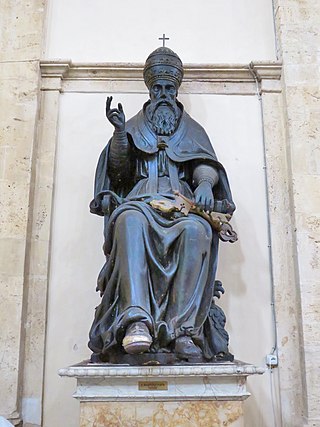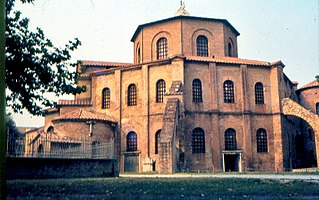
Pope Agatho served as the bishop of Rome from 27 June 678 until his death. He heard the appeal of Wilfrid of York, who had been displaced from his see by the division of the archdiocese ordered by Theodore of Canterbury. During Agatho's tenure, the Sixth Ecumenical Council was convened to deal with monothelitism. He is venerated as a saint by both the Catholic and Eastern Orthodox churches. He is said to have been the longest lived Pope ever.

Pope Honorius I was the bishop of Rome from 27 October 625 to his death. He was active in spreading Christianity among Anglo-Saxons and attempted to convince the Celts to calculate Easter in the Roman fashion. He is chiefly remembered for his correspondence with Patriarch Sergius I of Constantinople over the latter's monothelite teachings. Honorius was posthumously anathematized, initially for subscribing to monothelitism, and later only for failing to end it. The anathema against Honorius I became one of the central arguments against the doctrine of papal infallibility.

Pope Martin I, also known as Martin the Confessor, was the bishop of Rome from 21 July 649 to his death 16 September 655. He had served as Pope Theodore I's ambassador to Constantinople, and was elected to succeed him as pope. He was the only pope when Constantinople controlled the papacy whose election had not awaited imperial mandate. For his strong opposition to Monothelitism, Pope Martin I was arrested by Emperor Constans II, carried off to Constantinople, and ultimately banished to Cherson. He is considered a saint by both the Catholic Church and the Eastern Orthodox Church, as well as the last pope recognised as a martyr.
Pope Leo II was the Bishop of Rome from 17 August 682 to his death. One of the popes of the Byzantine Papacy, he is described by a contemporary biographer as both just and learned. He is commemorated as a saint in the Roman Martyrology on 28 June.

The Second Council of Constantinople is the fifth of the first seven ecumenical councils recognized by both the Eastern Orthodox Church and the Catholic Church. It is also recognized by the Old Catholics and others. Protestant opinions and recognition of it are varied. Some Protestants, such as Calvinists, recognize the first four councils, whereas Lutherans and most Anglo-Catholics accept all seven. Constantinople II was convoked by the Byzantine Emperor Justinian I under the presidency of Patriarch Eutychius of Constantinople. It was held from 5 May to 2 June 553. Participants were overwhelmingly Eastern bishops—only sixteen Western bishops were present, including nine from Illyricum and seven from Africa, but none from Italy—out of the 152 total.
Monothelitism, or monotheletism was a theological doctrine in Christianity that was proposed in the 7th century, but was ultimately rejected by the sixth ecumenical council. It held Christ as having only one will and was thus contrary to dyothelitism, the Christological doctrine accepted by most Christian denominations, which holds Christ as having two wills. Historically, monothelitism was closely related to monoenergism, a theological doctrine that holds Jesus Christ as having only one energy. Both doctrines were at the center of Christological disputes during the 7th century.

Pope Vitalian was the bishop of Rome from 30 July 657 to his death. His pontificate was marked by the dispute between the papacy and the imperial government in Constantinople over Monothelitism, which Rome condemned. Vitalian tried to resolve the dispute and had a conciliatory relationship with Emperor Constans II, who visited him in Rome and gave him gifts. Vitalian's pontificate also saw the secession of the Archbishopric of Ravenna from the papal authority.
Monoenergism was a notion in early medieval Christian theology, representing the belief that Christ had only one "energy" (energeia). The teaching of one energy was propagated during the first half of the seventh century by Patriarch Sergius I of Constantinople. Opposition to dyoenergism, its counterpart, would persist until Dyoenergism was espoused as Orthodoxy at the Sixth Ecumenical Council and monoenergism was rejected as heresy.
Sergius I was the Ecumenical Patriarch of Constantinople from 610 to 638. He is most famous for promoting Monothelite Christianity, especially through the Ecthesis.
Pyrrhus was the ecumenical patriarch of Constantinople from 20 December 638 to 29 September 641, and again from 9 January to 1 June 654.
Macarius I of Antioch was Patriarch of Antioch in the 7th century, deposed in 681 for professing monothelitism.
Paul II was the Ecumenical Patriarch of Constantinople from 1 October 641 to his death. He assumed regency for Byzantine emperor Constans II after a succession crisis in 641. Stephanos of Clypea appears to have served as secretary/scribe of Patriarch Paulus II of Constantinople against the Monothelites, in 646 AD. He was succeeded by Peter of Constantinople.
The Ecthesis is a letter published in 638 CE by the Byzantine emperor Heraclius which defined monotheletism as the official imperial form of Christianity.

In the history of Christianity, the first seven ecumenical councils include the following: the First Council of Nicaea in 325, the First Council of Constantinople in 381, the Council of Ephesus in 431, the Council of Chalcedon in 451, the Second Council of Constantinople in 553, the Third Council of Constantinople from 680 to 681 and finally, the Second Council of Nicaea in 787. All of the seven councils were convened in what is now the country of Turkey.

The Byzantine Papacy was a period of Byzantine domination of the Roman Papacy from 537 to 752, when popes required the approval of the Byzantine Emperor for their episcopal consecration, and many popes were chosen from the apocrisiarii or the inhabitants of Byzantine-ruled Greece, Syria, or Sicily. Justinian I reconquered the Italian peninsula in the Gothic War (535–554) and appointed the next three popes, a practice that would be continued by his successors and later be delegated to the Exarchate of Ravenna.
Dyothelitism or dithelitism is the Christological doctrine that teaches the existence of two wills in the person of Jesus Christ. Specifically, dyothelitism correlates the distinctiveness of two wills with the existence of two specific natures in the person of Jesus Christ, in a dyophysite context.
Dyoenergism is a particular Christological doctrine that teaches the existence of two energies in the person of Jesus Christ. Specifically, dyoenergism correlates the distinctiveness of two energies with the existence of two specific natures in the person of Jesus Christ, the position known as dyophysitism.

The Lateran Council of 649 was a synod held in the Basilica of St. John Lateran to condemn Monothelitism, a Christology espoused by many Eastern Christians, and Pope Honorius. The Council did not achieve ecumenical status in either East or West, but represented the first attempt of a pope to convene an ecumenical council independent of the Roman emperor.
The Typos of Constans was an edict issued by Eastern Roman emperor Constans II in 648 in an attempt to defuse the confusion and arguments over the Christological doctrine of Monotheletism. For over two centuries, there had been a bitter debate regarding the nature of Christ: the orthodox Chalcedonian position defined Christ as having two natures in one person, whereas Miaphysite opponents contended that Jesus Christ possessed but a single nature. At the time, the Byzantine Empire had been at near constant war for fifty years and had lost large territories. It was under great pressure to establish domestic unity. This was hampered by the large number of Byzantines who rejected the Council of Chalcedon in favour of Monophysitism.








